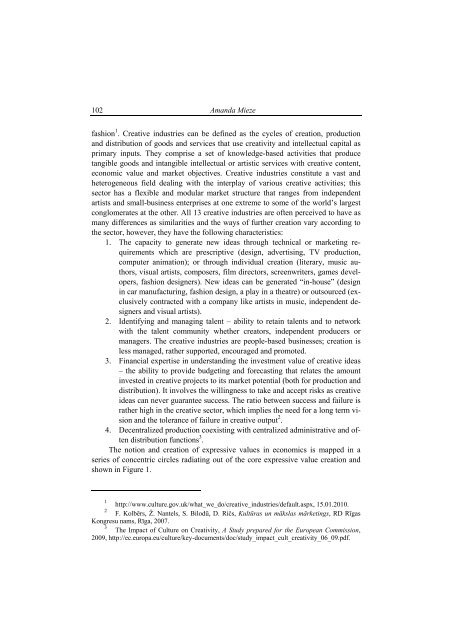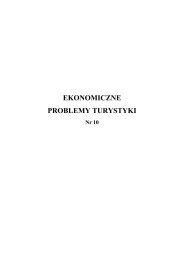Zeszyt naukowy - caÅoÅÄ - WydziaÅ ZarzÄ dzania i Ekonomiki UsÅug
Zeszyt naukowy - caÅoÅÄ - WydziaÅ ZarzÄ dzania i Ekonomiki UsÅug
Zeszyt naukowy - caÅoÅÄ - WydziaÅ ZarzÄ dzania i Ekonomiki UsÅug
Create successful ePaper yourself
Turn your PDF publications into a flip-book with our unique Google optimized e-Paper software.
102<br />
Amanda Mieze<br />
fashion 1 . Creative industries can be defined as the cycles of creation, production<br />
and distribution of goods and services that use creativity and intellectual capital as<br />
primary inputs. They comprise a set of knowledge-based activities that produce<br />
tangible goods and intangible intellectual or artistic services with creative content,<br />
economic value and market objectives. Creative industries constitute a vast and<br />
heterogeneous field dealing with the interplay of various creative activities; this<br />
sector has a flexible and modular market structure that ranges from independent<br />
artists and small-business enterprises at one extreme to some of the world’s largest<br />
conglomerates at the other. All 13 creative industries are often perceived to have as<br />
many differences as similarities and the ways of further creation vary according to<br />
the sector, however, they have the following characteristics:<br />
1. The capacity to generate new ideas through technical or marketing requirements<br />
which are prescriptive (design, advertising, TV production,<br />
computer animation); or through individual creation (literary, music authors,<br />
visual artists, composers, film directors, screenwriters, games developers,<br />
fashion designers). New ideas can be generated “in-house” (design<br />
in car manufacturing, fashion design, a play in a theatre) or outsourced (exclusively<br />
contracted with a company like artists in music, independent designers<br />
and visual artists).<br />
2. Identifying and managing talent – ability to retain talents and to network<br />
with the talent community whether creators, independent producers or<br />
managers. The creative industries are people-based businesses; creation is<br />
less managed, rather supported, encouraged and promoted.<br />
3. Financial expertise in understanding the investment value of creative ideas<br />
– the ability to provide budgeting and forecasting that relates the amount<br />
invested in creative projects to its market potential (both for production and<br />
distribution). It involves the willingness to take and accept risks as creative<br />
ideas can never guarantee success. The ratio between success and failure is<br />
rather high in the creative sector, which implies the need for a long term vision<br />
and the tolerance of failure in creative output 2 .<br />
4. Decentralized production coexisting with centralized administrative and often<br />
distribution functions 3 .<br />
The notion and creation of expressive values in economics is mapped in a<br />
series of concentric circles radiating out of the core expressive value creation and<br />
shown in Figure 1.<br />
1<br />
http://www.culture.gov.uk/what_we_do/creative_industries/default.aspx, 15.01.2010.<br />
2<br />
F. Kolbērs, Ž. Nantels, S. Bilodū, D. Ričs, Kultūras un mākslas mārketings, RD Rīgas<br />
Kongresu nams, Rīga, 2007.<br />
3<br />
The Impact of Culture on Creativity, A Study prepared for the European Commission,<br />
2009, http://ec.europa.eu/culture/key-documents/doc/study_impact_cult_creativity_06_09.pdf.

















